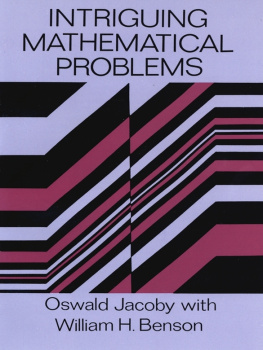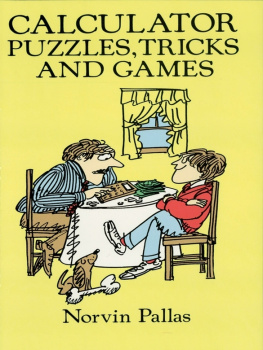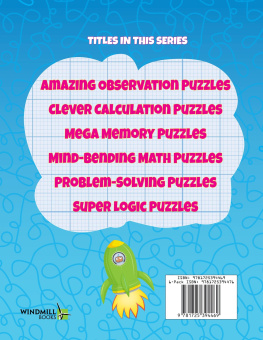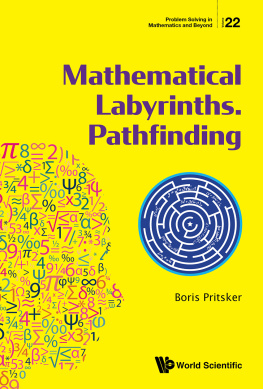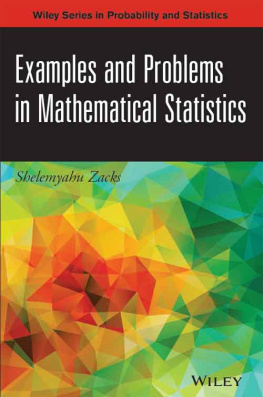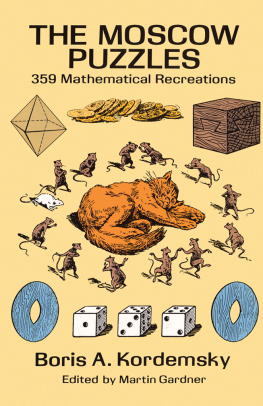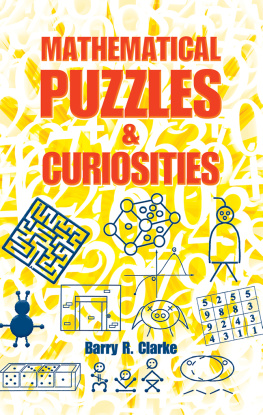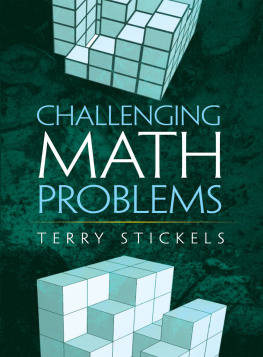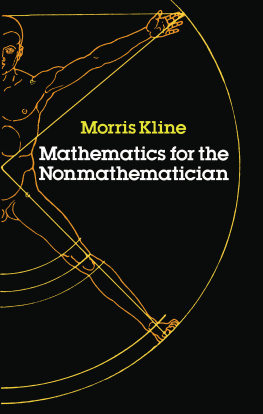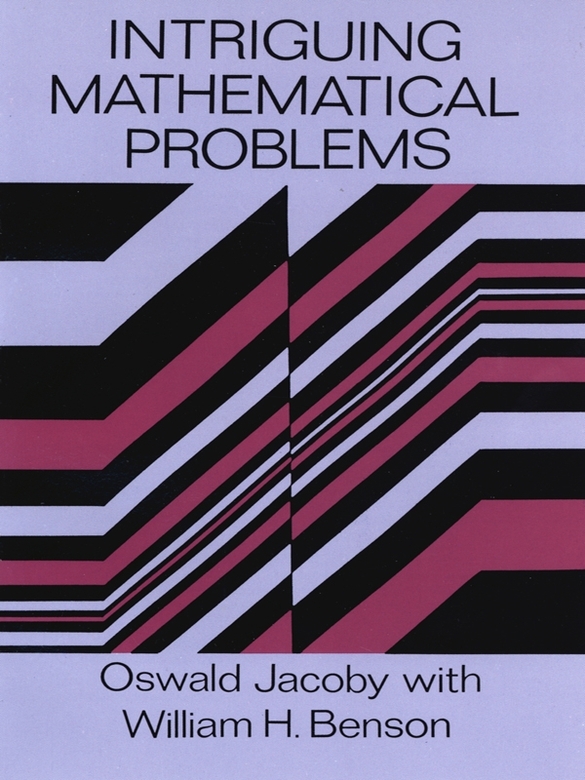fun with numbers
When man first began to countprobably well before he began to writeIt was only natural that he use the facilities he had. There were five fingers on each hand, so at first he counted to five and not long after that to ten. If he wanted to move into the realm of higher numbers he could use his ten toes and get as far as twenty. After that he had to start all over againwhich is why almost every language has a single-word name for each number up to twenty but starts with double and triple words from then on.
The use of the toes for counting never became very popular, even though man was counting nicely before he stopped going barefoot. It was easier to think of higher numbers as so many tens and units until the important number of ten tens was reached. A name was needed for this, and still another for ten tens of tens, so from very early times most languages have had words or symbols for hundred and thousand.
Written numeration (in its broadest sense) goes back to prehistoric man. The cuneiform baked-clay tablets of the Sumerians and the Babylonians, as well as Egyptian records on papyrus, prove that as long as five thousand years ago these peoples had a usable system of numbers. The Egyptian system is considered a decimal system: it had names and symbols for 10, 100, 1000, 10,000, 100,000, and 1,000,000; it did not, however, employ the principle of position or use a zero.
The Sumerians and Babylonians used a sexagesimal or 60-base system that did include the principle of position, and late in the game (about 200 B.C.) introduced a symbol for zero.
By the time they had reached the height of their culture, the Mayas of Central America had a calendar and a highly developed 20-base system of numbers that included zero and the principle of position.
The Greek system used the entire Greek alphabet as a series of symbols representing numbers in arithmetical operations. The Roman system, which also used specific letters and letter combinations to represent numbers, was an improvement but remained cumbersome and inefficient. Even with the abacus, which made addition and subtraction feasible, multiplication and division as we know these processes were not possible. Before arithmetic could gain any real momentum a better system was necessary.
During the early centuries of the Christian era the Hindus of India furnished the solution by formulating the principle of position and by the use of ten symbols to represent zero and the first nine digits. With these two developments, larger numbers could be expressed simply in terms of the position of each symbol. Thus 24 represents two tens and four units; 2304 represents two tens of tens of tens plus three tens of tens plus four units, or
2(10)3 + 3(10)2 + 0(10) + 4.
Despite the immediately obvious advantages of this system, not until around the beginning of the thirteenth century did it reach Western Europe (by way of Arabia), and its adoption there was not more or less complete until the beginning of the sixteenth century.
The system, good as it was, still left a problem with fractionsa problem that was solved by the introduction during the late sixteenth and early seventeenth centuries of the decimal system. After the decimal system began to be used, it became simple to represent two tens plus eight units plus one tenth plus six hundredths, for example, merely by writing 28.16. Just as each place to the left of the decimal point represents a multiplication by ten, so each place to the right represents a division by ten.
Both the Romans and the Egyptians had a word or symbol for ten, hundred, and thousand; we have words for much larger numbers. One million is one thousand thousands and is written 1,000,000; one billion is one thousand millions and is written 1,000,000,000; and one trillion is one thousand billions and is written 1,000,000,000,000. While Arabic numerals and the decimal point take care of reasonably large and reasonably small numbers, this does not mean that we can understand or visualize what a large number stands for. For instance, 376,987,543,843,217 is a fifteen-digit number. It can be referred to as three hundred seventy-six trillion, nine hundred eighty-seven billion, five hundred forty-three million, eight hundred forty-three thousand, two hundred seventeen. Beyond that its meaning is questionable. We also have words for even larger numbers, but unless we can express these larger numbers in terms of smaller numbers, they mean nothing to us.
And today we have increasing need for large numbers. Consider these: There are 31,536,000 seconds in one year; if a man could count at the rate often per second, it would take him more than three years to count to a billion. Astronomers have to deal with vast numbers, since the known universe covers a considerable amount of space. In order to simplify matters they use a unit known as the light year, the distance light travels in one year. Since light travels at the rate of a trifle over 186,000 miles per second, the number of miles in a light year is a thirteen-digit number slightly smaller than six trillion. Our national debt is a twelve-digit number, but our national wealth is conservatively estimated to be a thirteen-digit number. And 635,013,559,600 is a fairly well-known twelve-digit number; it represents the number of possible bridge hands a player can hold.
Most of the classic problems that deal with large numbers are concerned with the fact that when you multiply enough small numbers together you come up with a very large number.
Tradition has it that the inventor of the game of chess was invited by his emperor to name his own reward. All I ask, the inventor is supposed to have said, is to be awarded one grain of wheat for the first square on the chessboard, two grains for the second, four for the third, eight for the fourth, and so on. His Majesty laughed heartily and agreed at once to the apparently modest request. He changed his mind around the twenty-first square and had the man hanged. The emperor had to come up with 1,048,576 grains of wheat for that square and, although it was within his limits, he realized he would before too long exhaust his wheat resources. Just in case you dont know how many grains of wheat would eventually have been required, the answer is 264 1, or 18,446,744,073,709,551,615.
But for large numbers or small, when you solve the problems that follow in this section of the book, only the principles of arithmetic that are known to all of us will be involvedwith one possible exception: the concept of prime numbers. If you consider the basic arithmetical operations of addition, subtraction, multiplication, and division when applied to whole numbers (or integers), you will notice immediately that the sum, difference, or product of any two integers is also an integer. However, if you divide one integer by another, the result is not necessarily an integer; in fact, it is not likely to be an integer unless you have carefully chosen both divisor and dividend with this end in view.
Thus if you try dividing by 7 you will find that 7, 14, 21, 28, and so on are exactly divisible by 7, while all the intermediate integers are not. 8 is exactly divisible by 1, 2, 4, and 8; 9 by 1, 3, and 9; 12 by 1, 2, 3, 4, 6, and 12. Such divisors are known as factors of the numbers they divide exactly.
The integers 2, 3, 5, 7, 11, and all other numbers which contain no factors other than themselves and unity, are known as prime numbers. You will find of particular interest in several of the problems in this section the Fundamental Theorem of Arithmetic, which states that Except for order, any integer can be resolved into a product of primes in only one way.

